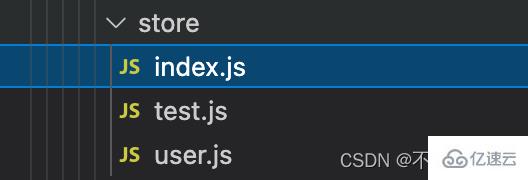这篇文章主要介绍“Vue项目中如何用Pinia状态管理工具”,在日常操作中,相信很多人在Vue项目中如何用Pinia状态管理工具问题上存在疑惑,小编查阅了各式资料,整理出简单好用的操作方法,希望对大家解答”Vue项目中如何用Pinia状态管理工具”的疑惑有所帮助!接下来,请跟着小编一起来学习吧!
Pinia与Vuex的区别
pinia只有store、getter、actions,么有mutations,简化了状态管理的操作。
pinia模块划分不需要modules
pinia自动化代码拆分
pinia对ts支持很好以及vue3的composition API
pinia体积更小,性能更好
使用Pinia
defineStore( )方法的第一个参数:容器的名字,名字必须唯一,不能重复defineStore( )方法的第二个参数:配置对象,放置state,getters,actionsstate属性: 用来存储全局的状态getters属性: 用来监视或者说是计算状态的变化的,有缓存的功能actions属性: 修改state全局状态数据,可以是异步也可以是同步Pinia可以用于vue2.x也可以用于vue3.x中
安装
yarn add pinia -S
main.js引入
import {createApp} from "vue"
import App from "./app.vue"
import store from "./store/index.js"
const app = createApp(App);
const store = createPinia();
app.use(store).mount("#app")
在store文件夹下新建test.js
import {definePinia} from "pinia"
export default testStore = definePinia('testId',{
state:()=>{
tname:"test",
tnum:0,
},
getters:{
changeTnum(){
console.log("getters")
this.tnum++;
}
},
actions:{
addNum(val){
this.tnum += val
}
},
//持久化存储配置
presist:{
enable:true,//
strategies:[
{
key:"testId",
storage:localStorage,
paths:['tnum']
}
]
}
})
在用actions的时候,不能使用箭头函数,因为箭头函数绑定是外部的this。actions里的this指向当前store
在store文件夹下新建index.js,便于管理
import {createPinia} from "pinia"
const store = createPinia();
export default store
新建
A.vue组件,引入store模块和storeToRefs方法storeToRefs:解构store中的数据,使之成为响应式数据
<template>
<div>
<div> {{tname}}</div>
<div> {{tid}}</div>
<div> tnum: {{tnum}}</div>
<div> {{tchangeNum}}</div>
<div><button @click="tchangeName">修改</button></div>
<div> <button @click="treset">重置</button></div>
<div @click="actionsBtn">actionsBtn</div>
</div>
</template>
<script setup>import { storeToRefs } from 'pinia'import { useStore } from '../store/user'import { useTest } from '../store/test.js'const testStore = useTest();let { tname, tchangeNum, tnum } = storeToRefs(testStore)</script>直接修改数据的两种方式
直接修改数据与使用$path修改数据相比,官方已经明确表示$patch的方式是经过优化的,会加快修改速度,对程序的性能有很大的好处。所以如果你是多条数据同时更新状态数据,推荐使用$patch方式更新。
虽然可以直接修改,但是出于代码结构来说, 全局的状态管理还是不要直接在各个组件处随意修改状态,应放于actions中统一方法修改(piain没有mutation)。
//直接修改数据
tchangeName(){
tname.value = "测试数据";
tnum.value++;
}
//当然也可以使用`$path`批量修改
tchangeName(){
testStore.$path(state=>{
state.tname = "测试数据";
state.value = 7;
})
}
使用actions修改数据
直接调用actions中的方法,可传参数
const actionsBtn = (){
testStore.addNum(5)
}
重置state中数据
store中有$reset方法,可以直接对store中数据重置
const treset = (){
testStore.$reset()
}
Pinia持久化存储
实现持久化存储,需要配合以下插件使用
yarn add pinia-plugin-persist
配置
store文件夹下的index.js文件,引入pinia-plugin-presist插件
import {createPinia} from "pinia"
import piniaPluginPresist from "pinia-plugin-presist"
const store = createPinia();
store.use(piniaPluginPresist)
export default store
配置stroe文件夹下的test.js文件,使用
presist属性进行配置
import {definePinia} from "pinia"
export default testStore = definePinia('testId',{
state:()=>{
tname:"test",
tnum:0,
},
getters:{
changeTnum(){
console.log("getters")
this.tnum++;
}
},
actions:{
addNum(val){
this.tnum += val
}
},
//持久化存储配置
presist:{
enable:true,//
strategies:[
{
key:"testId",
storage:localStorage,
paths:['tnum']
}
]
}
})
enable:true,开启持久化存储,默认为使用sessionStorage存储
-strategies,进行更多配置
-key,不设置key时,storage的key为definePinia的第一个属性,设置key值,则自定义storage的属性名storage:localStorage,设置缓存模式为本地存储paths,不设置时对state中的所用数据进行持久化存执,设置时只针对设置的属性进行持久化存储
Pinia模块化实现
模块化实现即在store对要使用的模块新建一个js文件,比如user.js文件。然后配置内容跟其他模块一样,根据自己需求进行设置,然后在对应页面引入。
Pinia中store之间互相调用
比如:test.js获取user.js中state的name属性值,在test.js引入user.js
import { defineStore } from 'pinia'
import { userStore } from "./user.js"
export const useTest = defineStore("testId", {
state: () => {
return {
tid: "111",
tname: "pinia",
tnum: 0
}
},
getters: {
tchangeNum() {
console.log('getters')
return this.tnum + 100
}
},
actions: {
tupNum(val) {
console.log('actions')
this.tnum += val;
},
getUserData() {
console.log(useStore().name);
return useStore().name;
},
},
persist: {
//走的session
enabled: true,
strategies: [
{
key: "my_testId",
storage: localStorage,
paths: ['tnum']
}
]
}
})
user.js中
import { defineStore } from 'pinia'
export const useStore = defineStore('storeId', {
state: () => {
return {
num: 0,
name: '张三'
}
}
})
A.vue组件中,调用test.js中getUserData方法就可以得到uesr.js中的name值
const actionBtn = () => {
testStore.getUserData()
};
到此,关于“Vue项目中如何用Pinia状态管理工具”的学习就结束了,希望能够解决大家的疑惑。理论与实践的搭配能更好的帮助大家学习,快去试试吧!若想继续学习更多相关知识,请继续关注编程网网站,小编会继续努力为大家带来更多实用的文章!








